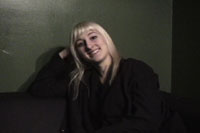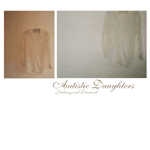 A record like this always sounds as though it belongs to a room full of neon lights, smoke, and half-faded memories. There's always something lingering just beneath the surface and it's never quite pretty, but it's always engaging: just like a dirty secret. These are the first images that come to mind when I hear the slinky guitars, winding percussion, and the organic production. Having an organic sound is the best way to describe each track on Jealousy and Diamond: guitars fade into and out of each other, strange and warm hums permeate each instance of every sound, and the percussion more or less blurs the line between melodic and completely percussive instruments.
A record like this always sounds as though it belongs to a room full of neon lights, smoke, and half-faded memories. There's always something lingering just beneath the surface and it's never quite pretty, but it's always engaging: just like a dirty secret. These are the first images that come to mind when I hear the slinky guitars, winding percussion, and the organic production. Having an organic sound is the best way to describe each track on Jealousy and Diamond: guitars fade into and out of each other, strange and warm hums permeate each instance of every sound, and the percussion more or less blurs the line between melodic and completely percussive instruments.
Two new shows just for you. We have squeezed out two extended release episodes for this weekend to get you through this week. They contain mostly new songs but there's also new issues from the vaults. The first show features music from Rider/Horse, Mint Field, Robert Aiki Aubrey Lowe, Anastasia Coope, ISAN, Stone Music, La Securite, Bark Psychosis, Jon Rose, Master Wilburn Burchette, Umberto, Wand, Tim Koh, Sun An, and Memory Drawings. The second episode has music by Laibach, Melt-Banana, Chuck Johnson, X, K. Yoshimatsu, Dorothy Carter, Pavel Milyakov, Violence Gratuite, Mark Templeton, Dummy, Endon, body / negative, Midwife, Alberto Boccardi, Divine. Cow in Maui from Veronika in Vienna. Get involved: subscribe, review, rate, share with your friends, send images! |



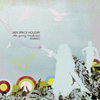 This collection of reworked versions of Marc Bianchi's 2003 albumincludes remixes that stay close to his original versions as well asadventurous deconstructions. By keeping the same running order as theoriginal LP, the set is much more listenable than many remix projects,as there is only one version of each track. By selecting a group ofremixers that are likeminded, he has ensured that the album won't straytoo far from various combinations of pop music and electronica. Thisworks to the advantage and disadvantage of the set. The Album Leaf doesaway with the chaotic beat programming of "The Young Machines" andinstead offers a pleasant, but ultimately uneventful melodic electronicversion. Arab Strap's take on "Something To Do With My Hands" is thebest example of a new version that keeps the structure of the originalsong intact, while improving upon its arrangement. The beat they haveused in place of the original's is simply much better, placing the songin a more contemporary setting. Interestingly, Arab Strap vocalistAidan Moffat has resisted the temptation to add his own vocals to thisremix, as he has done to others in the past. The Stereolab version of"Girl Problem" is the most deconstructed, recontextualized track of theset. It's hard to tell if they've used any sounds from the originaltrack at all. They have added what sounds like organ, drums, and allmanner of strange analog keyboard sounds, and in the process have madea better track than anything on their own last few albums. Thejuxtaposition of Bianchi's lyrics "I've got a girl problem; I've got adrug problem..." against this absurdist backdrop of bleeps and organbursts goes miles toward downplaying his often overly emotionalleanings. Super Furry Animals take on "Sleepy California" is a case inwhich a similar juxtaposition is less successful, as they have setdepressing lyrics about a dying grandmother to silly, bouncy music. Sixof the ten remixers have kept the original's vocals intact,highlighting the importance of storytelling in Her Space Holiday songs.To their credit, none of the remixers have used repeated vocalfragments, which are often annoying. Matmos and Blockhead havecompletely removed the vocals from their respective remixes of "TechRomance" and "Meet The Pressure." They both offer excellent, highlydeconstructed pieces based on a few elements from the original. Thebeautiful, weepy strings which Matmos have used as a key element intheir instrumental version of "Tech Romance" prove that Bianchi doesn'talways need to rely on direct lyrics to strike an emotional chord inhis listeners. While it may have been interesting to hear a few actsless familiar than these pop/electronica sympathizers try to remixtracks, it may have disrupted the flow of the album. By choosing areliable, if slightly conservative, group of remixers, this album hasturned out to be a highly enjoyable companion piece to The Young Machines.
This collection of reworked versions of Marc Bianchi's 2003 albumincludes remixes that stay close to his original versions as well asadventurous deconstructions. By keeping the same running order as theoriginal LP, the set is much more listenable than many remix projects,as there is only one version of each track. By selecting a group ofremixers that are likeminded, he has ensured that the album won't straytoo far from various combinations of pop music and electronica. Thisworks to the advantage and disadvantage of the set. The Album Leaf doesaway with the chaotic beat programming of "The Young Machines" andinstead offers a pleasant, but ultimately uneventful melodic electronicversion. Arab Strap's take on "Something To Do With My Hands" is thebest example of a new version that keeps the structure of the originalsong intact, while improving upon its arrangement. The beat they haveused in place of the original's is simply much better, placing the songin a more contemporary setting. Interestingly, Arab Strap vocalistAidan Moffat has resisted the temptation to add his own vocals to thisremix, as he has done to others in the past. The Stereolab version of"Girl Problem" is the most deconstructed, recontextualized track of theset. It's hard to tell if they've used any sounds from the originaltrack at all. They have added what sounds like organ, drums, and allmanner of strange analog keyboard sounds, and in the process have madea better track than anything on their own last few albums. Thejuxtaposition of Bianchi's lyrics "I've got a girl problem; I've got adrug problem..." against this absurdist backdrop of bleeps and organbursts goes miles toward downplaying his often overly emotionalleanings. Super Furry Animals take on "Sleepy California" is a case inwhich a similar juxtaposition is less successful, as they have setdepressing lyrics about a dying grandmother to silly, bouncy music. Sixof the ten remixers have kept the original's vocals intact,highlighting the importance of storytelling in Her Space Holiday songs.To their credit, none of the remixers have used repeated vocalfragments, which are often annoying. Matmos and Blockhead havecompletely removed the vocals from their respective remixes of "TechRomance" and "Meet The Pressure." They both offer excellent, highlydeconstructed pieces based on a few elements from the original. Thebeautiful, weepy strings which Matmos have used as a key element intheir instrumental version of "Tech Romance" prove that Bianchi doesn'talways need to rely on direct lyrics to strike an emotional chord inhis listeners. While it may have been interesting to hear a few actsless familiar than these pop/electronica sympathizers try to remixtracks, it may have disrupted the flow of the album. By choosing areliable, if slightly conservative, group of remixers, this album hasturned out to be a highly enjoyable companion piece to The Young Machines.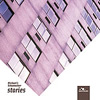 Schumacher is an artist for whom the passage between sound installation, performance pieces, and isolated recorded works has been an increasingly fluid process. His first release since last year's lauded Room Pieces, Stories covers much of the same thematic ground, confusing concepts of atmospheric, incidental sound "events" with the markers of a scripted, real-time performance. Here, Schumacher's interest is an exploration of the narrative urges latent in musical composition and the expansion of these urges, as both the context in which a piece emerges, and the way a piece is constructed, are shown to be fragmented, multifarious.
Schumacher is an artist for whom the passage between sound installation, performance pieces, and isolated recorded works has been an increasingly fluid process. His first release since last year's lauded Room Pieces, Stories covers much of the same thematic ground, confusing concepts of atmospheric, incidental sound "events" with the markers of a scripted, real-time performance. Here, Schumacher's interest is an exploration of the narrative urges latent in musical composition and the expansion of these urges, as both the context in which a piece emerges, and the way a piece is constructed, are shown to be fragmented, multifarious.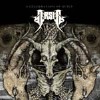 It's pretty much impossible these days to spit in any direction at aNorth American metal/hardcore festival and miss some band for whom AtThe Gates' Slaughter of the Soul forms the backbone of their sound.While a well-intentioned and, while being disturbingly over-rated,solid album, most of the unlistenable trash that has been spewed forthas melodic death metal over the past decade can be traced back to thisone blip on the musical landscape. Thankfully, the merry men in Arsishave emerged from four years of relative obscurity in Virginia spentcrafting their debut album and what could easily be considered thefirst melodic death masterpiece of the 21st century. Gone are theclich? that have plagued all but a handful of bands, for they have beenreplaced by this amazing razor sharp, ultra catchy, simply wonderfulcollection of tunes that will have even the most modest of peoplelonging to grow their hair out, throw up the horns, and have a greattime trying to keep up. Setting the pace right out of the gate with theferocious "The Face of My Innocence," it becomes immediately clear thatthis isn't your older brother's death metal, but something completelyoriginal and without equal on the modern metal landscape. There is notone single recycled riff, not one slightly uninteresting passage, notone second where you might doubt that you are hearing something thathasn't been done before with this type of precision and raw power. Theyeven manage to make the usually snore-inducing verse-chorus-verse songstructure work on "Maddening Disdain" with Malone tapping out a playfulmelody over drummer Michael VanDyne's ever-steady double bassonslaught. A true original toeing the line between vicious andmischievous with an authoritative expertise that concedes to neither,"A Celebration of Guilt" truly is the definition of essential.
It's pretty much impossible these days to spit in any direction at aNorth American metal/hardcore festival and miss some band for whom AtThe Gates' Slaughter of the Soul forms the backbone of their sound.While a well-intentioned and, while being disturbingly over-rated,solid album, most of the unlistenable trash that has been spewed forthas melodic death metal over the past decade can be traced back to thisone blip on the musical landscape. Thankfully, the merry men in Arsishave emerged from four years of relative obscurity in Virginia spentcrafting their debut album and what could easily be considered thefirst melodic death masterpiece of the 21st century. Gone are theclich? that have plagued all but a handful of bands, for they have beenreplaced by this amazing razor sharp, ultra catchy, simply wonderfulcollection of tunes that will have even the most modest of peoplelonging to grow their hair out, throw up the horns, and have a greattime trying to keep up. Setting the pace right out of the gate with theferocious "The Face of My Innocence," it becomes immediately clear thatthis isn't your older brother's death metal, but something completelyoriginal and without equal on the modern metal landscape. There is notone single recycled riff, not one slightly uninteresting passage, notone second where you might doubt that you are hearing something thathasn't been done before with this type of precision and raw power. Theyeven manage to make the usually snore-inducing verse-chorus-verse songstructure work on "Maddening Disdain" with Malone tapping out a playfulmelody over drummer Michael VanDyne's ever-steady double bassonslaught. A true original toeing the line between vicious andmischievous with an authoritative expertise that concedes to neither,"A Celebration of Guilt" truly is the definition of essential.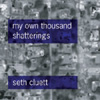 The title comes from poet and mescaline-prophet Henri Michaux; it is his vision of standing in a rainstorm, its persistent torrents, rather than enacting cleansing or comfort, are instead divisive, penetrating the body towards a thunderous disintegration. "I was, and was not, I was caught yet I was lost, I was in a state of complete ubiquity. The thousands upon thousands of rustlings were my own thousand shatterings." Three recordings make up sound artist Seth Cluett's own homage to rain, one a field recording taken during a storm, the preceding two consecutive reworkings of the resulting master tape. Cluett presents the three parts in "reverse" order: the first was created last as a reinterpretation or a remembering of the second, which was performed as a live manipulation of the original tape, a performance guided by the artist's recollections of the experience of recording the source material, presented unchanged in the third section.
The title comes from poet and mescaline-prophet Henri Michaux; it is his vision of standing in a rainstorm, its persistent torrents, rather than enacting cleansing or comfort, are instead divisive, penetrating the body towards a thunderous disintegration. "I was, and was not, I was caught yet I was lost, I was in a state of complete ubiquity. The thousands upon thousands of rustlings were my own thousand shatterings." Three recordings make up sound artist Seth Cluett's own homage to rain, one a field recording taken during a storm, the preceding two consecutive reworkings of the resulting master tape. Cluett presents the three parts in "reverse" order: the first was created last as a reinterpretation or a remembering of the second, which was performed as a live manipulation of the original tape, a performance guided by the artist's recollections of the experience of recording the source material, presented unchanged in the third section. The year 2004 might be remembered as the Year of Arthur Russell. Although the artist died of AIDS more than a decade ago, leaving behind a large and varied body of work, he lived and died in an unintelligible fog of near-total obscurity. Kicked off by The World of Arthur Russell, the Soul Jazz label's compilation of the artist's crucial disco productions, the year also saw the release of Calling Out of Context, the debut release for Audika Records, a label devoted to releasing Arthur Russell's works for posterity.
The year 2004 might be remembered as the Year of Arthur Russell. Although the artist died of AIDS more than a decade ago, leaving behind a large and varied body of work, he lived and died in an unintelligible fog of near-total obscurity. Kicked off by The World of Arthur Russell, the Soul Jazz label's compilation of the artist's crucial disco productions, the year also saw the release of Calling Out of Context, the debut release for Audika Records, a label devoted to releasing Arthur Russell's works for posterity. This album is a fine addition to the Hymen catalog. As the labeldoesn't issue new albums all the time, it is obvious that they areselective with regards to what they release. Having a high level ofstandards has paid off with Scatterheart,Benny Boysen's second release as Hecq. His sense of dynamics is a keyelement to his music's success. During "Doraccle" the shifts betweenloud and quiet are extreme, and help to sustain a level of tensionwithin the music. At 61 minutes the album is long, but the variety ofsounds and textures keeps the set interesting. The way Egyptianpercussion and pizzicato strings are used on "Flood Me" make it ahighlight of the album. His use of these unusual textures shows thathis influences are more varied than those of many electronic producers.Although Boysen is technically proficient at programming intricatebeats, he doesn't let the process become the focus of the music.Instead the set retains an emotional feel, although it often soundscold and mechanical. There is always an underlying drone or atmospherictexture that keeps the tracks grounded in human emotion. The openingtrack "FDK" begins with over a minute of droning, whirling tones beforethe beat kicks in. From this point on, the percussive patterns arejuxtaposed with the atmospheric elements. By focusing on one element orthe other, there is the possibility to listen with a different focuseach time. The inclusion of several short interludes consisting ofsampled dialogue also helps the set to retain a human quality. Thisseems to be a direct reference to the "skits" often featured betweenthe songs on hip hop albums. While many electronic acts talk of theinfluence hip hop has had on their work, Boysen has addressed thissubtly within the configuration of the album itself. The fact that thedialogue is from films also emphasizes Scatterheart's cinematicquality. Although there is a great amount of variance of sounds betweenthese tracks, they work well together as a whole and flow well into oneanother. Although there are many short tracks among the 23 featured,each seems to last long enough to effectively present an idea, withoutsounding unfinished. The running order is well organized, with "TBE,"the loudest, most chaotic track, placed at the halfway point. Thisshort track's noisy barrage of percussion balances the set perfectly.It's refreshing to find that although there are so many peopleproducing instrumental electronic music today, there is still thepossibility to create an album as fresh sounding as Scatterheart.
This album is a fine addition to the Hymen catalog. As the labeldoesn't issue new albums all the time, it is obvious that they areselective with regards to what they release. Having a high level ofstandards has paid off with Scatterheart,Benny Boysen's second release as Hecq. His sense of dynamics is a keyelement to his music's success. During "Doraccle" the shifts betweenloud and quiet are extreme, and help to sustain a level of tensionwithin the music. At 61 minutes the album is long, but the variety ofsounds and textures keeps the set interesting. The way Egyptianpercussion and pizzicato strings are used on "Flood Me" make it ahighlight of the album. His use of these unusual textures shows thathis influences are more varied than those of many electronic producers.Although Boysen is technically proficient at programming intricatebeats, he doesn't let the process become the focus of the music.Instead the set retains an emotional feel, although it often soundscold and mechanical. There is always an underlying drone or atmospherictexture that keeps the tracks grounded in human emotion. The openingtrack "FDK" begins with over a minute of droning, whirling tones beforethe beat kicks in. From this point on, the percussive patterns arejuxtaposed with the atmospheric elements. By focusing on one element orthe other, there is the possibility to listen with a different focuseach time. The inclusion of several short interludes consisting ofsampled dialogue also helps the set to retain a human quality. Thisseems to be a direct reference to the "skits" often featured betweenthe songs on hip hop albums. While many electronic acts talk of theinfluence hip hop has had on their work, Boysen has addressed thissubtly within the configuration of the album itself. The fact that thedialogue is from films also emphasizes Scatterheart's cinematicquality. Although there is a great amount of variance of sounds betweenthese tracks, they work well together as a whole and flow well into oneanother. Although there are many short tracks among the 23 featured,each seems to last long enough to effectively present an idea, withoutsounding unfinished. The running order is well organized, with "TBE,"the loudest, most chaotic track, placed at the halfway point. Thisshort track's noisy barrage of percussion balances the set perfectly.It's refreshing to find that although there are so many peopleproducing instrumental electronic music today, there is still thepossibility to create an album as fresh sounding as Scatterheart.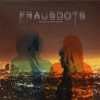 When I first looked at the cover of this CD and the title, my immediatethought was "Please kill me at this very moment and save me from themusic inside, as it's bound to be incredibly pretentious LA glam popwith a European slant, and I can't stand any more of that. Thank you,whoever hears." I'm glad to say I wasn't entirely right, but there areelements of truth to it, and therefore the record surprised me, thoughultimately I did not like it much. Brent Rademaker (Further/BeachwoodSparks) and Michelle Loiselle have a clear knack for pop songs andmelodies, but they seem rather big on glitz and appearance as the linernotes show. This can be an indication of a band without much substance,and the beginning of the record almost reflects that. "Dead Wrong"opens with a slight rephrasing of "Horse With No Name" in a faux GaryNuman delivery. Then, something shocking happens, as the verse hashorrible lyrics, but the chorus takes orbit and firmly finds its placeamong the stars ("Now everybody's doing everybody wrong, andeverybody's singing everybody else's song"). So, in a way, it's anironic parody that opens the record, and that's a bit acceptable, butthe lyrics are still lackluster, and the overall aesthetic seemsborrowed, as well. Plus, the song goes on 45 seconds longer than itshould, into a "doo doo doo" breakdown that is more doo doo. Still, theconcept delivers a benefit of doubt response, and a hope that othersongs will improve it. Sadly, no. "Fashion Death Trends" is where thealbum gets its insidious title, and seems to be about changingattitudes with clothes, and has lyrics in places like "Hello HelloHello" and "Goodbye Goodbye Goodbye." Other songs have promise, withbetter lyrics and more variation, like "The Extremists" and "SoftLight." Then "A Go-see" comes and destroys the momentum. Basically, itdoesn't get anywhere, and it does it real quick. It's derivative, butit has promise; so that's at least one positive thing.
When I first looked at the cover of this CD and the title, my immediatethought was "Please kill me at this very moment and save me from themusic inside, as it's bound to be incredibly pretentious LA glam popwith a European slant, and I can't stand any more of that. Thank you,whoever hears." I'm glad to say I wasn't entirely right, but there areelements of truth to it, and therefore the record surprised me, thoughultimately I did not like it much. Brent Rademaker (Further/BeachwoodSparks) and Michelle Loiselle have a clear knack for pop songs andmelodies, but they seem rather big on glitz and appearance as the linernotes show. This can be an indication of a band without much substance,and the beginning of the record almost reflects that. "Dead Wrong"opens with a slight rephrasing of "Horse With No Name" in a faux GaryNuman delivery. Then, something shocking happens, as the verse hashorrible lyrics, but the chorus takes orbit and firmly finds its placeamong the stars ("Now everybody's doing everybody wrong, andeverybody's singing everybody else's song"). So, in a way, it's anironic parody that opens the record, and that's a bit acceptable, butthe lyrics are still lackluster, and the overall aesthetic seemsborrowed, as well. Plus, the song goes on 45 seconds longer than itshould, into a "doo doo doo" breakdown that is more doo doo. Still, theconcept delivers a benefit of doubt response, and a hope that othersongs will improve it. Sadly, no. "Fashion Death Trends" is where thealbum gets its insidious title, and seems to be about changingattitudes with clothes, and has lyrics in places like "Hello HelloHello" and "Goodbye Goodbye Goodbye." Other songs have promise, withbetter lyrics and more variation, like "The Extremists" and "SoftLight." Then "A Go-see" comes and destroys the momentum. Basically, itdoesn't get anywhere, and it does it real quick. It's derivative, butit has promise; so that's at least one positive thing.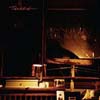 On this double CD, their third release, Jesse Poe's Tanakh have abandoned songwriting and shifted their attention to creating dark atmospheric soundscapes. Seven musicians contribute to the project, including Pat Best, who must have felt right at home here, as the shifting drones sometimes recall his work with Pelt. The music sounds very much a product of the cavernous temple in which it was recorded.
On this double CD, their third release, Jesse Poe's Tanakh have abandoned songwriting and shifted their attention to creating dark atmospheric soundscapes. Seven musicians contribute to the project, including Pat Best, who must have felt right at home here, as the shifting drones sometimes recall his work with Pelt. The music sounds very much a product of the cavernous temple in which it was recorded.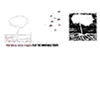 When a band concocts a formula that is not easily classifiable and isalmost indecipherable at times yet is complete compelling and causeslong periods of not wanting to turn the repeat function off on the CDplayer, they are to be congratulated. Infectious, sinewy, ever-morphingand pulsing with energy almost describe any music from the Berg SansNipple, but these songs are particularly demonstrative of theircreative abilities. The quiet chimes that start the proceedings arequickly augmented by beefy hip hop drums and falsetto vocals that areunrecognizable and cut up jitter-style as the need arises. Low keys arejoined by high squelches and a lovely chimes breakdown, and the trackdrives on with the sinister underbelly of a corrupt afterlife. Perfectsounds for Purgatory, hence the track's title, and just when it seemslike it's all over the wattage increases to 150% for the last twominutes. Then horns break the darkness open and usher in the holinessof "Hark, the Poonie Angel Sings!" Processed vocals mixed with keyscreate an eerie choir from the beyond, and tainted breathy whispersinfect like the dream passages of REM sleep. The track does notoverstay its welcome, luckily, though I found it puzzling that theangels get less say than the poor souls in Purgatory; maybe they'rejust less interesting. "Swordfighting" is a bit crunchier, with a noirbackdrop, much like the theme music for a man on a revenge streak,searching out the next person in the group who ratted him out. The sameghostly choir is present, like the souls to be redeemed egging on theevil work to be done. At four minutes it is a bit repetitious, but notoverbearingly so. The CD closes with the more experimental and quietpulsing of "Memory Hole," and in just twenty minutes the group hasraised hairs and slicked them back, applying a relaxing massage rightat the end. It's a gamut to be run, and they pass without incident.
When a band concocts a formula that is not easily classifiable and isalmost indecipherable at times yet is complete compelling and causeslong periods of not wanting to turn the repeat function off on the CDplayer, they are to be congratulated. Infectious, sinewy, ever-morphingand pulsing with energy almost describe any music from the Berg SansNipple, but these songs are particularly demonstrative of theircreative abilities. The quiet chimes that start the proceedings arequickly augmented by beefy hip hop drums and falsetto vocals that areunrecognizable and cut up jitter-style as the need arises. Low keys arejoined by high squelches and a lovely chimes breakdown, and the trackdrives on with the sinister underbelly of a corrupt afterlife. Perfectsounds for Purgatory, hence the track's title, and just when it seemslike it's all over the wattage increases to 150% for the last twominutes. Then horns break the darkness open and usher in the holinessof "Hark, the Poonie Angel Sings!" Processed vocals mixed with keyscreate an eerie choir from the beyond, and tainted breathy whispersinfect like the dream passages of REM sleep. The track does notoverstay its welcome, luckily, though I found it puzzling that theangels get less say than the poor souls in Purgatory; maybe they'rejust less interesting. "Swordfighting" is a bit crunchier, with a noirbackdrop, much like the theme music for a man on a revenge streak,searching out the next person in the group who ratted him out. The sameghostly choir is present, like the souls to be redeemed egging on theevil work to be done. At four minutes it is a bit repetitious, but notoverbearingly so. The CD closes with the more experimental and quietpulsing of "Memory Hole," and in just twenty minutes the group hasraised hairs and slicked them back, applying a relaxing massage rightat the end. It's a gamut to be run, and they pass without incident. 